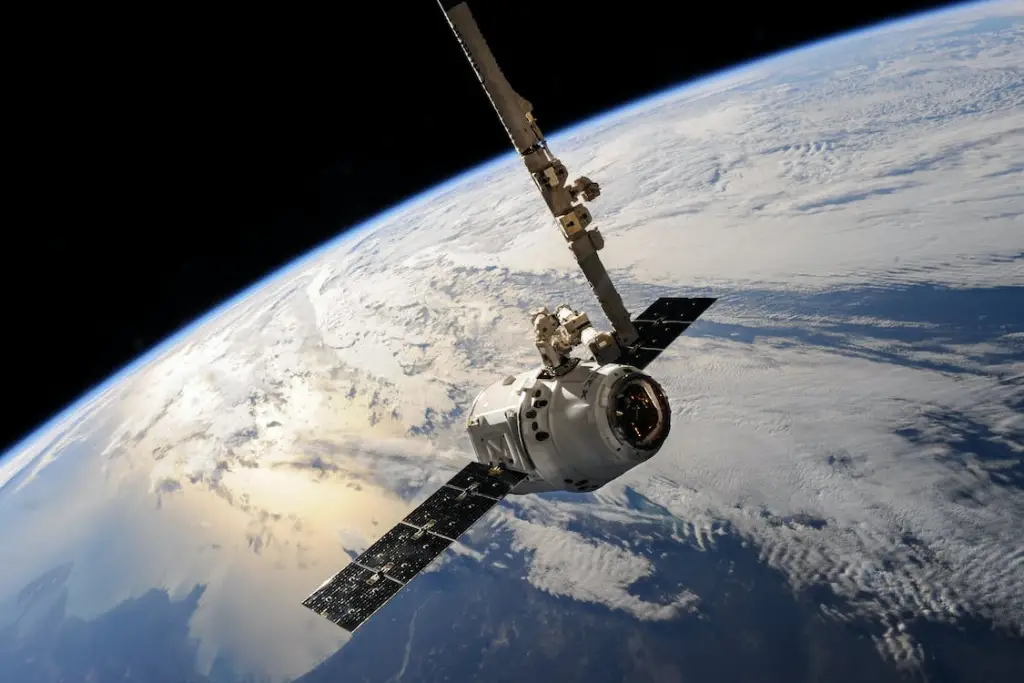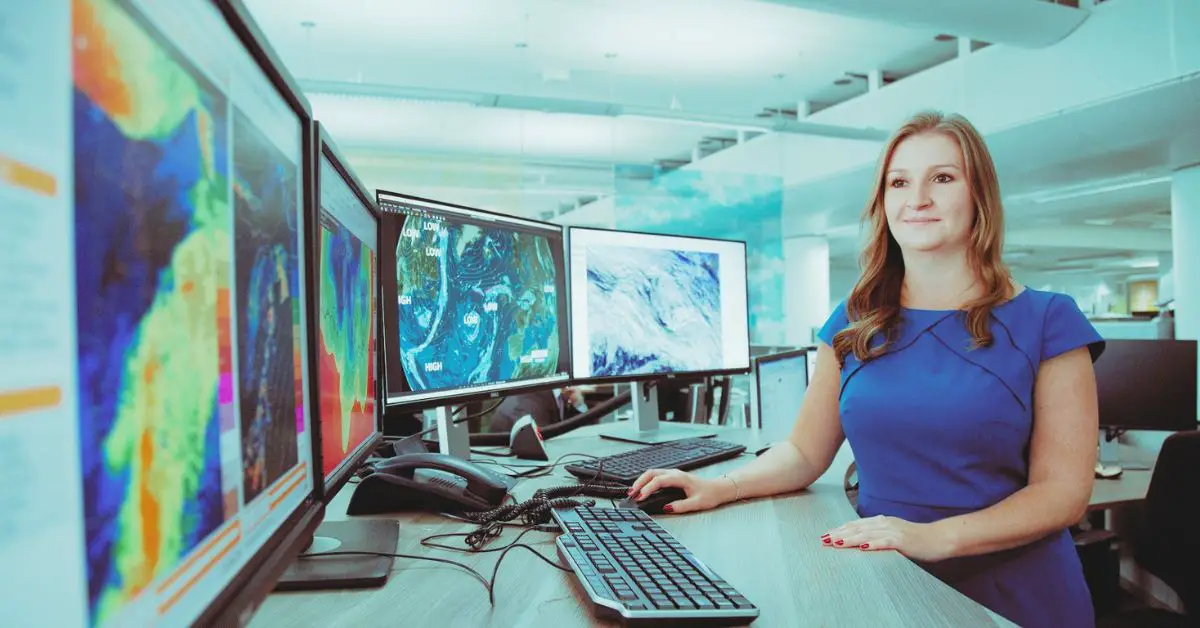We used the latest data and insights to identify the highest paying meteorology jobs so that you can learn and earn more.
Do you know the highest-paying meteorology jobs? Meteorologists are a unique bunch, constantly chasing storms and forecasting the weather.
If you’ve ever wondered what kind of salary you could expect if you went into this line of work, look no further than our list below.
We sourced data from the US Bureau of Labor Statistics, Glassdoor, and other reputable sources to discover the highest-paying jobs in meteorology.
You Might Also Want To Know:
- 10 Highest Paying Architecture Jobs to Consider
- 10 Highest Paying Jobs For Biophysics Majors to Consider
- 10 Highest Paying Digital Marketing Jobs to Consider
Table of Contents
#10. Marine Meteorologist
How much do they get paid?
- Source: ZipRecruiter
- Low Range: $21,000 per year
- High Range: $142,000 per year
- Median Pay: $64,399 per year

What do they do?
Marine meteorologists study the oceans and seas. They use complex computer models to help predict the weather, especially when storms or hurricanes are likely to hit. These meteorologists also study changes in ocean temperature and currents, which can affect climate change.
What degrees and skills are usually required?
Most marine meteorologists have a bachelor’s degree in marine meteorology. They also need to be able to use complex computer models. Some employers prefer applicants with an advanced degree in a related field.
Who’s hiring for this job?
Marine meteorologist work for national and international weather services, oceanographic institutions, and private companies.
The US National Oceanic and Atmospheric Administration hires marine meteorologists at its offices across the country. Some marine meteorologists work for ship-based research organizations or government or private research labs.
What is the best way to get this job?
It’s important to have a bachelor’s degree in marine meteorology or another related field. You should also gain experience working with weather data and models.
The U.S. National Oceanic and Atmospheric Administration offer various internships for meteorology, oceanography, or marine biology students.
Should you become a marine meteorologist?
#9. Weather Forecaster
How much do they get paid?
- Source: ZipRecruiter
- Low Range: $30,000 per year
- High Range: $107,000 per year
- Median Pay: $64,931 per year

What do they do?
A weather forecaster is an expert in predicting the future of the atmosphere and its effect on Earth’s surface.
Their goal is to provide accurate and timely forecasts for communities, businesses, government agencies, and other organizations that rely on their information. These meteorologists may use computer models and historical data about past weather events to predict current conditions.
What degrees and skills are usually required?
Aspiring weather forecasters should have a bachelor’s degree in meteorology or atmospheric science. They may also need to complete an internship or training program before getting a job.
Who’s hiring for this job?
Meteorologists work in private companies, government agencies, and universities. They can also work as television meteorologists for local news stations or as weather reporters for radio stations.
What is the best way to get this job?
The best way to get your first job as a meteorologist is by getting an education. You can find schools that offer bachelor’s and master’s degrees in meteorology or atmospheric science. Once you have graduated, you can look for jobs in the field.
You can also get a job as a weather observer or weather technician. These jobs are entry-level positions and don’t require much education. You will learn about the profession by working at these jobs for a few years before moving on to something else.
What’s it like to be a weather forecaster?
You Might Also Want To Know:
- 10 Highest Paying Kinesiology Jobs to Consider
- 10 Highest Paying Earth Science Jobs to Consider
- 10 Highest Paying Jobs For Biotechnology Majors to Consider
#8. Broadcast Meteorologist
How much do they get paid?
- Source: Glassdoor
- Low Range: $43,000 per year
- High Range: $110,000 per year
- Median Pay: $67,939 per year

What do they do?
A broadcast meteorologist is someone who reports on weather conditions for television or radio stations.
They work in all types of media, from local news stations to radio shows, podcasts, and websites. Their goal is to keep their audience informed on the latest weather developments and how those changes may impact their daily lives.
What degrees and skills are usually required?
Broadcast meteorologists typically hold a degree in meteorology or atmospheric science. This helps them gain the necessary knowledge and skills to accurately forecast weather conditions for their audiences.
In addition, many of these professionals also have a background in broadcasting or journalism. This knowledge gives them a better understanding of how to effectively communicate with people from all walks of life.
Who’s hiring for this job?
Broadcast meteorologists can find jobs in television, radio, and online news outlets. They are also frequently employed by government agencies and private consulting firms that specialize in weather forecasting.
What is the best way to get this job?
You can get your start by earning a degree in meteorology, which will give you the knowledge and skills needed to become a broadcast meteorologist.
You can also gain valuable experience through internships with local news stations or by working as an assistant to someone who already has this job.
What’s it like to be a broadcast journalist?
#7. Operational Meteorologist
How much do they get paid?
- Source: ZipRecruiter
- Low Range: $24,500 per year
- High Range: $151,000 per year
- Median Pay: $78,379 per year

What do they do?
Operational meteorologists are responsible for providing forecasts, warnings, and advisories to the public. They work closely with other meteorologists who gather data from weather balloons and satellites, crunch the numbers and interpret them into useful information.
What degrees and skills are usually required?
You’ll need a bachelor’s degree in meteorology, which can take four years to complete. You may also want to earn a graduate degree in atmospheric science or meteorology from an accredited program.
However, some employers require at least a high school diploma before considering you for an entry-level position. You’ll also need strong communication skills, as you may have to explain weather phenomena to the public.
Who’s hiring for this job?
Operational meteorologists work for local, state, and federal agencies. You may also find jobs with private companies in fields like aviation and broadcasting.
These meteorologists earn a median salary of $78,379 per year. This varies depending on your level of experience.
What is the best way to get this job?
Some meteorologists start their careers as weather observers. This position is ideal for those who enjoy working outdoors and is often a stepping stone to higher-level jobs.
You may be able to get an entry-level job with only a high school diploma and some academic training in the field. However, most employers require at least a bachelor’s degree in atmospheric science or meteorology.
What’s it like to be an operational meteorologist?
You Might Also Want To Know:
- 10 Highest Paying Fashion Jobs to Consider
- 10 Highest Paying Graphics Design Jobs to Consider
- 10 Highest Paying Accounting Jobs To Consider
#6. Remote Meteorologist
How much do they get paid?
- Source: ZipRecruiter
- Low Range: $24,500 per year
- High Range: $162,000 per year
- Median Pay: $85,543 per year

What do they do?
Remote meteorologists are scientists who monitor the weather from a location away from the area where they are observing. They use satellite images to analyze cloud formations and other weather factors.
What degrees and skills are usually required?
You’ll need a bachelor’s degree in meteorology or other related fields. Some employers may require candidates to have a master’s degree. You should also have excellent written and verbal communication skills since you will be communicating with your team and other meteorologists via phone and email.
Who’s hiring for this job?
You can find jobs with local, state, and federal government agencies. You may also work in the private sector for companies that provide weather services to farmers or other industries that rely on accurate forecasts.
Many factors determine the average meteorologist salary. This may include your expertise, experience, and employer.
What is the best way to get this job?
A meteorology degree can help you land a job in the field. You can also gain experience by volunteering with your local National Weather Service office or through an internship at a television station or weather forecasting company.
What’s it like to be a meteorologist?
#5. Weather Analyst
How much do they get paid?
- Source: Comparably
- Low Range: $50,630 per year
- High Range: $132,180 per year
- Median Pay: $89,820 per year

What do they do?
A weather analyst is a professional who studies the weather and makes predictions about it. They work for television stations, newspapers, or other media outlets. Most of their work is done in front of a computer screen, where they analyze data from satellites and radar sites to make predictions.
What degrees and skills are usually required?
A weather analyst needs a bachelor’s degree in meteorology or atmospheric science and some experience.
This job requires you to be able to interpret data, so you also need strong computer skills. The other important skill is communication. You need to be able to explain your findings in a way that’s easy for people who aren’t meteorologists to understand.
Who’s hiring for this job?
Television stations and media outlets are often in need of weather analysts. You can also find jobs with government agencies. The average base salary of these professionals depends on their job description, experience, and employer.
What is the best way to get this job?
You can get a job as a junior weather analyst by taking classes in meteorology and learning how to use computer programs. After working for a few years, you can apply for a more senior position.
What’s it like to be a weather analyst?
You Might Also Want To Know:
- 10 Highest Paying Human Resources Jobs to Consider
- 10 Highest Paying Marketing And Advertising Jobs to Consider
- 10 Highest Paying Jobs For Sports Science Majors
#4. Atmospheric Scientist
How much do they get paid?
- Source: ZipRecruiter
- Low Range: $30,500 per year
- High Range: $157,000 per year
- Median Pay: $90,086 per year

What do they do?
As the name suggests, an atmospheric scientist studies the atmosphere. They look at how the air interacts with other parts of the environment, such as water and land. Atmospheric scientists may study weather patterns, climate change, pollution, or air quality issues.
These scientists are interested in how changes in atmospheric conditions affect people and animals.
What degrees and skills are usually required?
Atmospheric scientists usually have at least a bachelor’s degree in meteorology, atmospheric science, or related fields. They may also earn master’s degrees or doctorates in these fields. Many atmospheric scientists have backgrounds in physics, chemistry, biology, geology, and other sciences.
Who’s hiring for this job?
Employers that hire atmospheric scientists include government agencies, colleges and universities, research organizations, and private companies. Atmospheric scientists may work in offices or out in the field.
What is the best way to get this job?
To become an atmospheric scientist, you will usually need a bachelor’s degree in meteorology, atmospheric science, or related fields. You can also earn a master’s degree or doctorate.
Many employers prefer candidates with at least 5 years of experience; however, entry-level positions exist for those just starting out.
Should you become an atmospheric scientist?
#3. Metrology Engineer
How much do they get paid?
- Source: Glassdoor
- Low Range: $69,000 per year
- High Range: $153,000 per year
- Median Pay: $102,369 per year

What do they do?
Metrology engineers are responsible for ensuring the accuracy of measurement tools.
They work directly with scientists and engineers to ensure their equipment is in working order, calibrating everything from microscopes to satellites. This means that they have a lot of opportunities for advancement, as well as room to grow their knowledge base.
What degrees and skills are usually required?
A metrology engineering job typically requires a bachelor’s degree in engineering, mathematics, or physics. They must also be skilled at working with complex equipment and instruments as well as computers.
Who’s hiring for this job?
Metrology engineers are employed in many industries, including manufacturing, healthcare, aerospace, and government. They also work for organizations that perform research and development in these fields.
What is the best way to get this job?
You can find employment through various avenues, including job boards and networking sites. You may also consider attending industry conferences or events where you can meet potential employers face-to-face.
What’s it like to be a metrology engineer?
You Might Also Want To Know:
- 10 Highest Paying Mechanical Engineering Jobs
- 10 Highest Paying Jobs For Philosophy Majors
- 10 Highest Paying Music Jobs
#2. Research Meteorologist
How much do they get paid?
- Source: Glassdoor
- Low Range: $63,000 per year
- High Range: $175,000 per year
- Median Pay: $104,201 per year

What do they do?
A research meteorologist is a scientist who studies the atmospheric conditions of Earth. They study cloud formations, weather patterns and temperatures, air pollution, and global warming. These meteorologists may also conduct laboratory experiments to test various theories about how these elements interact.
What degrees and skills are usually required?
Research meteorologists typically have at least a master’s degree in meteorology or atmospheric science. Some may also have a Ph.D. in one of these fields as well. They must be able to interpret data and perform complex calculations, which requires strong math skills.
Who’s hiring for this job?
You can find jobs as a research meteorologist with federal and state agencies, private research organizations, and educational institutions.
What is the best way to get this job?
You can get a research meteorologist job by earning a bachelor’s or master’s degree in meteorology, atmospheric science, or another related field. You may also need to complete an internship with a research organization.
As this is not an entry-level position, it is a good idea to get some experience working in meteorology or another field of science before you apply.
What’s it like to be a research meteorologist?
#1. Forensic Meteorologist
How much do they get paid?
- Source: Salary.com
- Low Range: $59,154 per year
- High Range: $152,887 per year
- Median Pay: $104,621 per year

What do they do?
Forensic meteorologists are a subgroup of meteorologists who use their knowledge of weather, climate, and atmospheric science to investigate crimes. They often work for law enforcement agencies as expert witnesses in court cases.
These scientists collect evidence from weather events, study it and then testify about the cause of the crime and how it was committed. Forensic meteorologists increase awareness about severe weather events, such as tornadoes or hurricanes, that could potentially harm people or property.
What degrees and skills are usually required?
Forensic meteorologists generally have a bachelor’s degree in meteorology, but some work towards a master’s or doctorate.
In addition, they must know how to use scientific methods like data collection and analysis to determine the role the weather plays in a particular crime.
Who’s hiring for this job?
Forensic meteorologists work for local police departments, federal agencies such as the FBI or CIA, and private companies specializing in security and investigation. The national average salary for these meteorlogists points to a lucrative specialist career.
What is the best way to get this job?
To become a forensic meteorologist, you should have a bachelor’s degree in meteorology. After obtaining this degree, you can take additional coursework in forensics at a local university or community college. This will help you gain the skills you need to become a forensic meteorologist.
Once you have your degree and have completed the necessary coursework, you can apply for an entry-level forensic meteorologist job.
Should you become a forensic meteorologist?
You Might Also Want To Know:
- 10 Highest Paying Communications Jobs
- 10 Highest Paying Hospitality Jobs
- 10 Highest Paying Interior Design Jobs
Conclusion
We hope you enjoyed this post on the highest-paying meteorology jobs. Meteorologists are paid fairly, depending on their level of experience, education, and other factors.
If you’re looking for more information about these jobs or want to learn more about other careers in the field of meteorology, leave a comment below. We’ll do our best to answer it.


